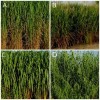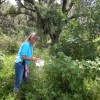 Nonnative invasive plant species pose a significant threat to Florida’s natural areas. The UF/IFAS Assessment of Nonnative Plants in Florida’s Natural Areas (hereafter, UF/IFAS Assessment) uses literature-based risk assessment tools to predict the invasion risk of both nonnative species that occur in the state as well as species proposed for introduction. The UF/IFAS Assessment team has evaluated more than 770 species, including 97 species proposed for introduction or new uses. The team is actively identifying and evaluating potentially problematic nonnative species (and sub-specific or hybrid taxa). Recommendations and supporting information from the UF/IFAS Assessment can be found at http://plants.ifas.ufl.edu/assessment. This 6-page fact sheet was written by Deah Lieurance, S. Luke Flory, Aimee L. Cooper, Doria R. Gordon, Alison M. Fox, Joan Dusky, and Linda Tyson, and published by the UF Department of Agronomy, November 2013.
Nonnative invasive plant species pose a significant threat to Florida’s natural areas. The UF/IFAS Assessment of Nonnative Plants in Florida’s Natural Areas (hereafter, UF/IFAS Assessment) uses literature-based risk assessment tools to predict the invasion risk of both nonnative species that occur in the state as well as species proposed for introduction. The UF/IFAS Assessment team has evaluated more than 770 species, including 97 species proposed for introduction or new uses. The team is actively identifying and evaluating potentially problematic nonnative species (and sub-specific or hybrid taxa). Recommendations and supporting information from the UF/IFAS Assessment can be found at http://plants.ifas.ufl.edu/assessment. This 6-page fact sheet was written by Deah Lieurance, S. Luke Flory, Aimee L. Cooper, Doria R. Gordon, Alison M. Fox, Joan Dusky, and Linda Tyson, and published by the UF Department of Agronomy, November 2013.
http://edis.ifas.ufl.edu/ag376
Tag: Alison M. Fox
Classical Biological Control of Tropical Soda Apple with Gratiana boliviana (ENY865/IN971)
 Tropical soda apple is a prickly shrub native to South America. First reported in Glades Co., Florida in 1988, it later spread to Georgia, Alabama, Louisiana, Texas, Mississippi, Tennessee, North Carolina, and South Carolina. It is a major problem in pastures and conservation areas. Negative impacts of tropical soda apple include reduction of cattle stocking rates, competition with native plants, and the costs associated with its control. Dense thickets of the weed also can disrupt the movement of wildlife. This 4-page fact sheet provides a summary of the major steps of the successful biological control program against tropical soda apple in Florida. The article covers the importance of the weed, identification and biology of the biological control agent, rearing and release efforts, establishment and impact, and efforts to communicate the outcomes of the program to stakeholders. Written by R. Diaz, J. Medal, K. Hibbard, A. Roda, A. Fox, S. Hight, P. Stansly, B. Sellers, J. Cuda and W. A. Overholt, and published by the UF Department of Entomology and Nematology, November 2012.
Tropical soda apple is a prickly shrub native to South America. First reported in Glades Co., Florida in 1988, it later spread to Georgia, Alabama, Louisiana, Texas, Mississippi, Tennessee, North Carolina, and South Carolina. It is a major problem in pastures and conservation areas. Negative impacts of tropical soda apple include reduction of cattle stocking rates, competition with native plants, and the costs associated with its control. Dense thickets of the weed also can disrupt the movement of wildlife. This 4-page fact sheet provides a summary of the major steps of the successful biological control program against tropical soda apple in Florida. The article covers the importance of the weed, identification and biology of the biological control agent, rearing and release efforts, establishment and impact, and efforts to communicate the outcomes of the program to stakeholders. Written by R. Diaz, J. Medal, K. Hibbard, A. Roda, A. Fox, S. Hight, P. Stansly, B. Sellers, J. Cuda and W. A. Overholt, and published by the UF Department of Entomology and Nematology, November 2012.
http://edis.ifas.ufl.edu/in971
SSAGR225/AG234 IFAS Assessment of Non-native Plants in Florida’s Natural Areas: Status Assessment
Revised! SS-AGR-225, a 28-page publication by Alison M. Fox, Doria R. Gordon, Joan A. Dusky, Linda Tyson, Randall K. Stocker, Kenneth A. Langeland, and Aimee L. Cooper, is the component of the IFAS Assessment that provides evaluations of plants that currently occur within Florida. designed to identify those non-native plant species that are invasive in areas of Florida where designated management objectives include the conservation of native biodiversity. Includes references. Published by the UF Department of Agronomy, April 2009.
http://edis.ifas.ufl.edu/ag234